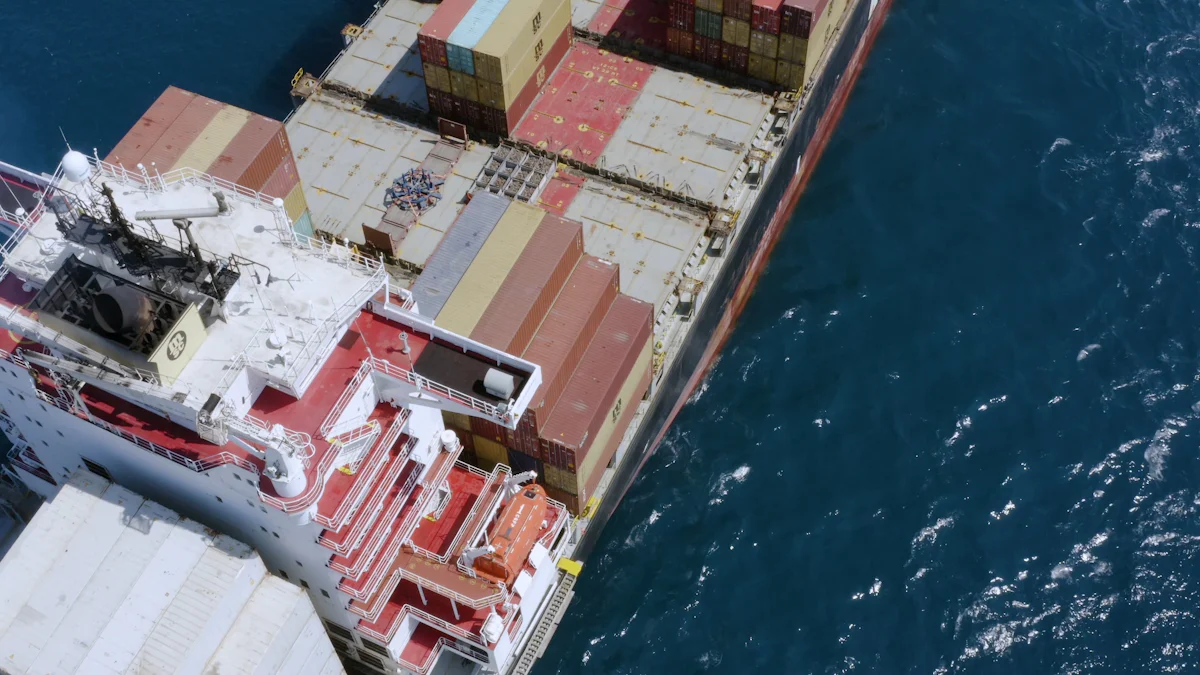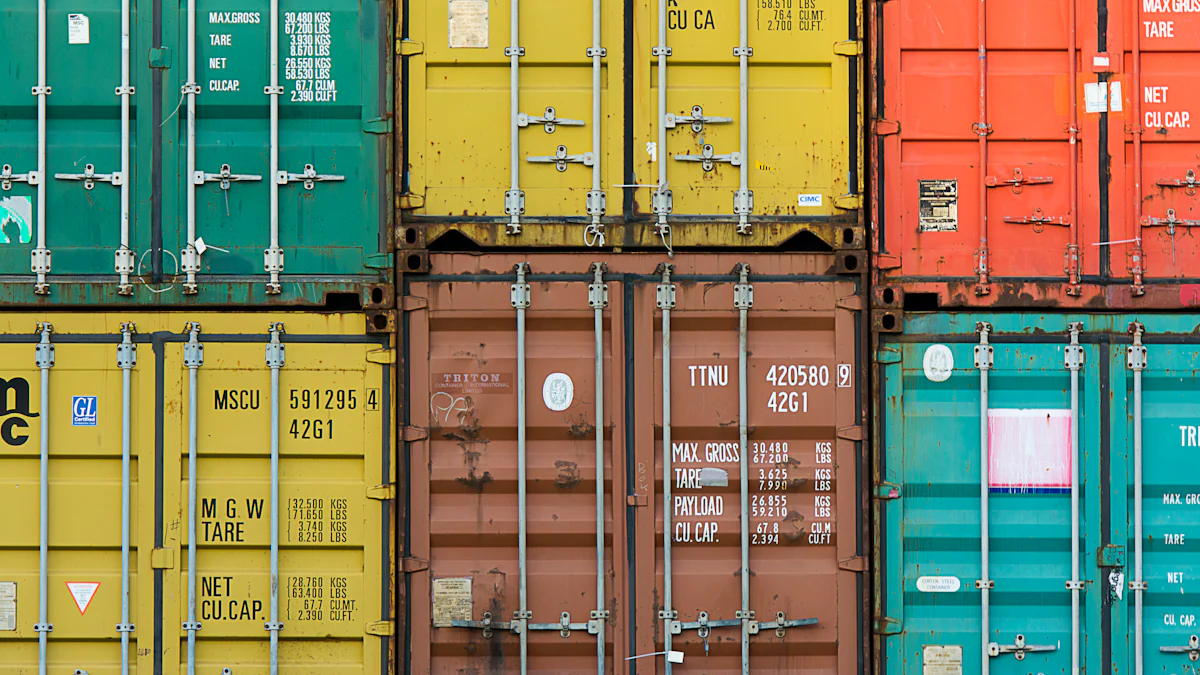A Simple Guide to Calculating Ocean Freight Charges

Shipping goods across oceans can feel overwhelming, especially when you encounter complex freight charges. These charges depend on factors like the weight and volume of your cargo, the shipping method you choose, and additional fees such as terminal handling or fuel surcharges. By understanding these elements, you gain control over your shipping expenses. For instance, knowing how freight costs are calculated allows you to avoid unnecessary fees and make smarter decisions. Mastering ocean freight details ensures your goods reach their destination efficiently without breaking your budget.
Key Takeaways
Understand the key components of ocean freight rates, including base freight rate, surcharges, and handling fees, to better manage your shipping costs.
Choose between Full Container Load (FCL) and Less than Container Load (LCL) shipping based on your cargo size and urgency to optimize expenses.
Calculate sea freight costs accurately by determining volumetric weight and accounting for additional charges like customs fees and insurance.
Utilize online tools and calculators to estimate freight rates and compare options for better pricing.
Stay informed about market trends and seasonal demand to anticipate changes in freight rates and plan your shipments effectively.
Build strong relationships with freight forwarders to leverage their expertise and negotiate better shipping rates.
Regularly review and adjust your shipping practices to identify cost-saving opportunities and streamline operations.
Understanding Ocean Freight Charges
Understanding how ocean freight charges are determined is essential for managing your shipping expenses effectively. By breaking down the components and factors influencing ocean freight rates, you can make informed decisions and secure cost-efficient shipping solutions.
Key Components of Ocean Freight Rates
Ocean freight rates consist of several key components that directly impact the total cost of shipping.
Base Freight Rate: This is the core cost of transporting your goods from the origin port to the destination port. It is typically calculated based on the weight or volume of your cargo.
Bunker Adjustment Factor (BAF): This surcharge accounts for fluctuations in fuel prices. Since fuel costs can vary significantly, the BAF ensures carriers can adjust rates accordingly.
Currency Adjustment Factor (CAF): Currency exchange rates between countries can impact shipping costs. The CAF compensates for these variations, ensuring carriers maintain profitability.
Terminal Handling Charges (THC): These fees cover the cost of loading and unloading cargo at ports. They vary depending on the port and the services required.
Documentation Fees: Shipping involves paperwork, including bills of lading and customs declarations. Documentation fees cover the administrative costs associated with processing these documents.
Each of these components contributes to the final freight rate. By understanding them, you can better evaluate freight quotations and identify opportunities to save.
Factors Influencing Sea Freight Rates
Sea freight rates are not static. They fluctuate based on a variety of factors, many of which are beyond your control.
Cargo Weight and Volume: The size and weight of your shipment play a significant role in determining costs. Larger or heavier shipments typically incur higher charges.
Shipping Route: The distance between the origin and destination ports affects rates. Longer routes or those passing through high-risk areas may result in higher costs.
Fuel Prices: Fuel is a major expense for shipping companies. When fuel prices rise, carriers often pass these costs on to shippers through surcharges.
Seasonality: Peak shipping seasons, such as the months leading up to major holidays, often see increased demand. This can drive up sea freight rates due to limited capacity.
Market Conditions: Global events, such as geopolitical tensions or economic downturns, can disrupt supply chains and impact freight rates. For example, port congestion or labor strikes may lead to higher costs.
Regulations and Compliance: Environmental regulations, such as those limiting sulfur emissions, can increase operational costs for carriers. These costs are often reflected in the rates you pay.
By staying informed about these factors, you can better predict changes in sea freight rates and adjust your shipping strategies to minimize expenses.
FCL vs. LCL Shipping: Cost Implications

Choosing between Full Container Load (FCL) and Less than Container Load (LCL) shipping can significantly impact your freight costs. Understanding the differences helps you make the right decision for your cargo and budget. FCL and LCL shipping can significantly impact your freight costs.
How to Calculate Sea Freight Costs
Calculating sea freight costs accurately ensures you avoid unexpected expenses and plan your shipping budget effectively. By understanding the steps involved, you can take control of your shipping process and make informed decisions.
Calculating Volumetric Weight and CBM
To calculate sea freight costs, you must first determine the volumetric weight and cubic meter (CBM) of your shipment. These measurements help carriers decide whether to charge based on weight or volume.
Measure Your Cargo Dimensions: Use a measuring tape to find the length, width, and height of your package in meters. For irregularly shaped items, measure the longest points.
Calculate CBM: Multiply the length, width, and height of your cargo. For example, if your package measures 2 meters long, 1 meter wide, and 1.5 meters high, the CBM is 2 × 1 × 1.5 = 3 cubic meters.
Determine Volumetric Weight: Multiply the CBM by the industry standard conversion factor, which is typically 1,000 kilograms per cubic meter. In this case, 3 CBM × 1,000 = 3,000 kilograms.
Compare Actual Weight and Volumetric Weight: Carriers will charge based on the higher value. If your cargo weighs 2,500 kilograms but has a volumetric weight of 3,000 kilograms, the latter will apply.
Understanding these calculations helps you estimate your freight costs more precisely and avoid surprises when receiving freight quotations.
Using Online Tools to Estimate Ocean Freight Rates
Online tools simplify the process of estimating ocean freight rates. These calculators allow you to input shipment details and receive instant cost estimates.
Freight Finders offers tools like the Sea Freight Calculator, which calculates costs based on weight, volume, and destination.
Forest Shipping provides the World Freight Rates Calculator and SeaRates Freight Calculator. These tools not only estimate costs but also suggest potential transit routes and shipping times.
GoComet Freight Cost Calculator enables you to compare rates from vendors worldwide, ensuring you get competitive pricing.
Pro Tip: Use multiple calculators to cross-check estimates and identify the most cost-effective option. This approach ensures you get the best value for your shipment.
These tools save time and provide transparency, helping you make informed decisions without relying solely on manual calculations.
Accounting for Additional Charges
When calculating sea freight costs, you must account for additional charges that can significantly impact the final price. These charges often vary depending on the shipping route, cargo type, and carrier policies.
Fuel Surcharges: Carriers adjust rates to reflect fluctuations in fuel prices. Keep an eye on these charges, as they can change frequently.
Terminal Handling Charges (THC): These fees cover the cost of loading and unloading cargo at ports. They differ based on the port and services required.
Customs Fees: Import and export regulations may require you to pay customs duties or taxes. These fees depend on the destination country and the nature of your goods.
Insurance Costs: Protecting your cargo against damage or loss adds to your overall expenses. While optional, insurance is highly recommended for valuable shipments.
By factoring in these charges, you can create a more accurate budget and avoid unexpected expenses. Always request a detailed freight quotation from your carrier to understand all applicable fees.
Remember: Transparency is key. Ask your carrier for a breakdown of charges to ensure there are no hidden fees.
Mastering these steps allows you to calculate sea freight costs with confidence. Whether you use online tools or manual methods, understanding the process ensures you stay in control of your shipping expenses.
Common Surcharges and Fees in Ocean Freight

When shipping goods via ocean freight, understanding the various surcharges and hidden fees is crucial. These additional costs can significantly impact your overall shipping expenses. By identifying these charges upfront, you can better prepare your budget and avoid surprises.
Types of Surcharges
Ocean freight involves several surcharges that carriers apply to cover specific operational costs. Familiarizing yourself with these charges helps you understand how they influence the freight rate. Below are some of the most common surcharges:
Bunker Adjustment Factor (BAF): This surcharge accounts for fluctuations in fuel prices. Since fuel is a major expense for carriers, the BAF ensures they can adjust rates to reflect current fuel costs.
Currency Adjustment Factor (CAF): Currency exchange rate variations between countries can affect shipping costs. The CAF compensates for these fluctuations, ensuring carriers maintain stable pricing.
Terminal Handling Charges (THC): These fees cover the cost of loading and unloading cargo at ports. They vary depending on the port and the services required.
Congestion Surcharge: Ports experiencing high traffic or delays may impose this fee. It compensates for the additional time and resources needed to handle shipments during congestion.
Overweight Surcharge (OWS): If your cargo exceeds the standard weight limits, carriers may apply this surcharge to cover the extra handling and transport requirements.
Special Equipment Surcharge (SEP): Shipments requiring specialized containers, such as refrigerated or oversized containers, incur this fee.
Automated Manifest Systems Filing (AMS): This fee applies to shipments entering certain countries, such as the United States, where carriers must electronically file cargo details before arrival.
These surcharges are standard in the industry and often appear in freight quotations. Knowing them allows you to evaluate quotes more effectively and choose the best option for your shipment.
Hidden Fees to Watch Out For
In addition to standard surcharges, hidden fees can unexpectedly inflate your shipping costs. These fees are not always transparent, so it’s essential to ask your carrier for a detailed breakdown. Here are some common hidden fees to be aware of:
Port Handling Fees: These charges cover services like cargo storage, inspection, and documentation at the port. They vary by location and can add up quickly.
Customs Duties and Taxes: Import and export regulations may require you to pay customs duties or taxes based on the value and type of goods being shipped.
Security Surcharge: This fee covers enhanced security measures, such as scanning and screening cargo, especially for high-risk shipments.
Peak Season Surcharge: During periods of high demand, such as holidays, carriers may impose this fee to account for limited capacity and increased operational costs.
Delivery Area Surcharge: If your shipment’s destination is in a remote or hard-to-reach area, carriers may charge extra for delivery.
Address Correction Fee: Providing incorrect shipping details can result in additional charges for correcting the information.
Insurance Costs: While optional, insuring your cargo against damage or loss is highly recommended. This cost depends on the value of your goods and the level of coverage you choose.
Pro Tip: Always request a comprehensive freight quotation from your carrier. Ensure it includes all potential surcharges and fees to avoid unexpected expenses.
By understanding these hidden fees, you can negotiate better terms with your carrier and plan your shipping budget more accurately. Awareness of both standard surcharges and hidden costs ensures you stay in control of your ocean freight expenses.
Tips to Optimize Your Ocean Freight Costs
Managing your ocean freight expenses effectively can lead to significant savings. By adopting smart strategies, you can reduce costs, streamline operations, and ensure your shipments remain within budget. Below are actionable tips to help you optimize your freight costs.
Reducing Shipping Expenses
Lowering your shipping expenses starts with evaluating your current practices and identifying areas for improvement. Here are some practical steps:
Consolidate Shipments: Combine smaller shipments into one larger load whenever possible. This reduces the number of trips and minimizes handling fees.
Choose the Right Container Size: Avoid paying for unused space by selecting a container that matches your cargo volume. For smaller loads, consider shared container options like LCL (Less than Container Load).
Negotiate with Carriers: Build strong relationships with carriers to secure better freight rates. Regular business with a carrier often leads to discounts or preferential pricing.
Optimize Packaging: Use compact and efficient packaging to maximize container space. This reduces the volumetric weight and lowers your overall shipping cost.
Monitor Market Trends: Stay informed about fluctuations in sea freight rates. Shipping during off-peak seasons or avoiding congested routes can result in lower charges.
Pro Tip: Regularly review your shipping practices to identify inefficiencies. Small adjustments can lead to substantial savings over time.
Partnering with Freight Forwarders
Collaborating with experienced freight forwarders can simplify the shipping process and help you save money. These professionals bring industry expertise and valuable connections to the table.
Expert Testimony: "Collaborating with experienced freight forwarders who possess the industry expertise can be immensely beneficial in navigating complex freight charge dynamics. These professionals can offer valuable insights, negotiate favorable rates, and help implement cost-saving strategies tailored to specific business needs." – Experienced Freight Forwarders
Freight forwarders can:
Negotiate on Your Behalf: They leverage their relationships with carriers to secure competitive rates and favorable terms.
Provide Expert Guidance: Their knowledge of shipping regulations, routes, and market conditions ensures you make informed decisions.
Streamline Operations: They handle documentation, customs clearance, and other logistics, saving you time and reducing errors.
Pro Tip: Choose a freight forwarder with a proven track record and strong industry connections. Their expertise can significantly impact your bottom line.
Planning Ahead to Avoid Extra Costs
Proper planning is essential to avoid unexpected expenses and delays. Taking a proactive approach ensures smoother operations and better cost management.
Book early: Reserve space with carriers well in advance to secure lower rates. Last-minute bookings often come with premium charges. Shipping costs can be significantly reduced with proper planning.
Prepare Accurate Documentation: Ensure all shipping documents are complete and error-free. Mistakes can lead to delays, fines, or additional fees.
Anticipate Seasonal Demand: Plan shipments around peak seasons to avoid higher prices. If shipping during busy periods is unavoidable, book early to lock in better rates.
Factor in Additional Charges: Account for surcharges like fuel adjustments, terminal handling fees, and customs duties when budgeting. Understanding these costs upfront helps you avoid surprises.
Pro Tip: Create a detailed shipping plan that includes timelines, cost estimates, and contingency measures. This minimizes risks and keeps your freight expenses under control.
By implementing these strategies, you can take full control of your ocean freight costs. Whether you focus on reducing expenses, leveraging the expertise of freight forwarders, or planning ahead, each step brings you closer to achieving cost-effective shipping solutions.
Understanding ocean freight charges empowers you to make informed decisions and optimize your shipping budget. By breaking down the components of freight rates, selecting the right shipping method, and accounting for additional fees, you can take control of your costs. This knowledge ensures you get the best out of ocean freight rates while avoiding unnecessary expenses. For complex shipments or when navigating overall ocean freight rates feels overwhelming, consulting a freight forwarder can provide valuable guidance. Their expertise helps you secure competitive prices and achieve the final freight amount that aligns with your budget.
FAQ
What are the key factors that affect ocean freight costs?
Several factors influence ocean freight costs, and understanding them can help you make informed decisions. The size and weight of your cargo play a significant role in determining the freight rate. Shipping routes also impact costs, as longer or less common routes often come with higher prices. Additionally, fuel surcharges, seasonality, and market conditions can cause fluctuations in ocean freight rates. By staying informed about these factors, you can better anticipate changes and plan your shipping budget effectively.
What are the basic concepts of ocean freight?
Ocean freight includes two primary shipping methods: Full Container Load (FCL) and Less Container Load (LCL). FCL involves renting an entire container, which is ideal for large shipments. Containers come in standard sizes like 20GP, 40GP, and 40HQ. LCL allows you to share container space with other shippers, making it suitable for smaller loads. Understanding these concepts helps you choose the most cost-effective option for your cargo.
How can you reduce container shipping costs?
Reducing container shipping costs requires strategic planning. Consolidate smaller shipments into one larger load to save on handling fees. Choose the right container size to avoid paying for unused space. Negotiate with carriers for better freight rates and optimize your packaging to maximize container space. Monitoring market trends and shipping during off-peak seasons can also help you secure lower prices.
How can shippers avoid overpaying for shipping surcharges?
To avoid overpaying for surcharges, you must understand the additional fees carriers may impose. These include fuel surcharges, terminal handling charges, and customs duties. Always request a detailed freight quotation to identify hidden fees. By comparing multiple freight quotations and asking for transparency, you can make smarter choices and avoid unnecessary expenses.
Why is it important to understand ocean freight rates?
Understanding ocean freight rates is crucial for managing your shipping costs effectively. Reviewing freight quotations carefully ensures you comprehend all charges and avoid unexpected expenses. Familiarity with carrier terms and conditions helps you identify opportunities to save and ensures you get the best out of ocean freight rates.
See Also
Discovering Top Global Logistics Firms: An In-Depth Guide
Maximizing Savings in Logistics: A Complete Handbook
Exploring Innovations in Sea Freight Logistics for 2024
Analyzing the Future Trends of LTL Freight Services
Essential Insights on Eco-Friendly Transport in Supply Chains
